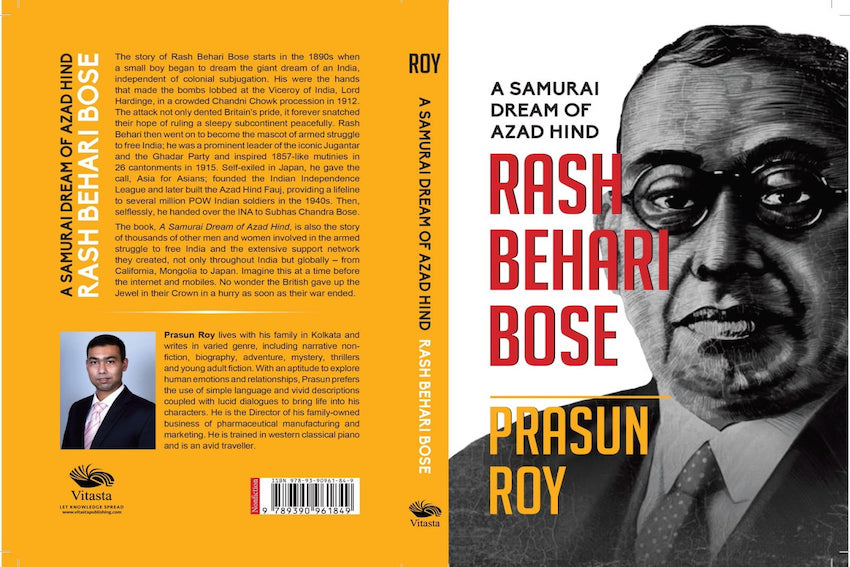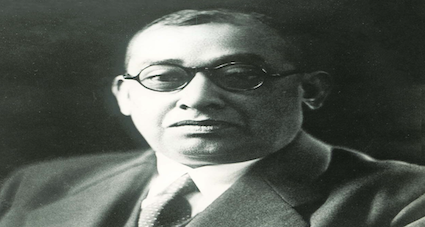Amidst the brouhaha over the 125th birth anniversary of Subhas Chandra Bose, a book is silently reminding Indians that their most enigmatic nationalist hero would not have made much headway against the British if he had not been backed by another Bose.
Rash Behari Bose, the founder of Indian National Army (INA) hardly finds mention in the media, even the Indian government rarely talks about him.
And it bothers author Prasun Roy, an engineer, whose book, A Samurai Dream of Azad Hind – Rash Behari Bose hit the stands last year. I have a feeling the idea behind the book is to make Indians aware of Rash Behari Bose, whose exploits against the British forces have found mention in history books but never popularised. So, Roy researched hard and worked on the book, published by Vitasta Publishing. The book has loads of details and takes a deeper look at the life and times of the nationalist who inspired Subhas Chandra Bose, especially during his days in Japan where he plotted against the British forces.
So, at the outset, the readers must know who Rash Behari Bose was and what were his thoughts for India, right? Some 25 pages into the book is an interesting incident about Rash Behari Bose where he was offered a copy of Ananda Math written by Bankim Chandra Chattopadhyay. A young Rash Behari immersed himself in the book and then, as the author writes: “The fiery sentiment of Ananda Math and the account of the Sannyasi Rebellion in Bengal in the 18th century mingled with the blatant struggles of the French Revolution of 1789 and created a chiaroscuro of turbulence in his mind. The militant ideology hidden in the pages of Ananda Math blended with the actual rebellion in France and germinated in Rash Behari’s young mind a hope of freeing India through armed struggle.” It was clear to his parents and friends that Rash Behari wanted to use World War II and his days in Japan in the fight for India’s independence.
The book has some fascinating details about Rash Behari, especially the one where he and his friend Basanta Biswas – the latter was dressed as a woman – lobbed country made bombs on December 23, 1912 when British Viceroy Lord Hardinge formally declared the transfer of British India’s capital from Calcutta (not Kolkata then) to Delhi. The bombs exploded on the elephant carrying Lord Hardinge but the British Viceroy was saved as his personal attendant bore the brunt and was flung from the elephant. Writes the author: “Lord Hardinge screamed in pain as the blazing fragments of the bomb injured back, legs and head and tore away the flesh from his shoulder. Lady Hardinge’s elegant dress caught fire and the elephant became restive.”

Rash Behari, who believed in armed struggle in liberating India from British rule, was the founder of the Indian National Army, a pro-independence movement that collaborated with the Japanese and the Germans against the British in World War II. Rash Behari later handed the reins of the INA to Subhas Chandra Bose after some intense deliberations as to how INA should take on the British forces and enter India through its northeastern corridors.
Brilliantly written and recounted with anecdotes from pages of history, the book narrates some of Rash Behari Bose’s successes and some of his failures. I thought the chapter titled Betrayed was brilliantly written where the author talks about the failure of the Ghadar Movement because of some mole who sucked up to the British intelligence and spilled the beans. This, in turn, messed up the entire plan shaped by Rash Behari and his men. Many were arrested, tortured and executed, Rash Behari had to backstep and plan new moves. Rash Behari was down but not out. He eventually went to Chandannagar, the French colony on the banks of the Hooghly.
And eventually, Rash Behari sailed aboard Sanuki Maru in June, 1915, to reach Japan and disguised himself as a distant relative of Rabindranath Tagore. Rash Behari was in an alien land, and he always thought of his home, India. After all, he was a true nationalist, Rash Behari reminded himself time and again: He had to win freedom for India; he could not lose.
And after spending some considerable years in Japan grooming a band of soldiers, Rash Behari eventually decided to hand over the INA to Subhas Chandra Bose. Writes the author: “In the interest of India, the prisoners, and his brainchildren, the creator of the Indian Independence League and the INA shed his ego, and with open arms Rash Behari welcomed Subhas Chandra Bose and invited him to take up the reins of these organisations and lead his beloved India into the daylight of freedom.” What brilliant lines.
Read this one. Rash Behari said: “Subhas is an untamed lion who cannot be kept caged. He took great risks to escape from India in April 1914 towards Germany. He understood that India could not attain liberty from slavery if he remained a prisoner in the country. Friends, in this man, I can see a reflection of my own journey, and perhaps a much greater one for him. He commands the love and the hearts of millions in India and across the world, He is Netaji, in him I see my dream come true.”
Let me leave the rest for the readers to fish from the book. Rash Behari encountered loads of tensions in Japan and eventually married a Japanese woman to settle in the Land of the Rising Sun. And how he worked as a reporter, and also introduced the Indian curry.
Everyone knows about the INA and its glorious march towards India. Subhas Bose held the helm of INA from July 1943 to August 1946. The INA soldiers and Japanese soldiers failed to capture the Kohima ridge. And then, it was a big loss at the hands of the British forces, who were backed by the US air force.
And then, a frail Rash Behari Bose died in Tokyo on January 21, 1945 at his home.
Many moons later, the debate still rages throughout India about what eventually happened to Subhas Chandra Bose and his mysterious disappearance. One set of India still believes Subhas Chandra Bose reportedly died of burns in a plane crash near Taipei on his way to Tokyo on August 18, 1945. Successive studies and research have confirmed that Subhas Chandra Bose never died in the airplane crash. And that ashes in a Japanese temple are not of Subhas Chandra Bose but that of a Japanese soldier.
Many Indians never believed the air crash theory. There have been recurrent accounts of his being seen in the Soviet Union after that date. No one knows why the Indian government continued to fund the upkeep of the ashes.
And then, there is the big research and investigation done by my friends Anuj Dhar and Chandrachur Ghose who have conclusively proved that the saint who lived in Uttar Pradesh as Gumnami Baba was none other than Subhas Chandra Bose. But let’s take a break and focus on this book. It’s about Rash Behari Bose, the man who created the foundation stone for Subhas Chandra Bose to rise to his glory.
Will the Indian government buy copies and distribute it to schools and colleges? No, it will not happen. Will an island be named after Rash Behari Bose? That too is a tough call, who will lobby the Prime Minister’s Office (PMO) for Rash Behari Bose. The best alternative is to buy this brilliant book, read it and treasure it at home. We are a billion plus nation now, some sales can always happen. Indians must know about their great nationalist who did everything to upstage the British and eventually died in a faraway land.
(Shantanu Guha Ray is a Wharton-trained journalist and award-winning author. He lives in Delhi with his wife and two pets. He won the 2018 Crossword award for his book, Target, which probed the NSEL payment crisis.)


